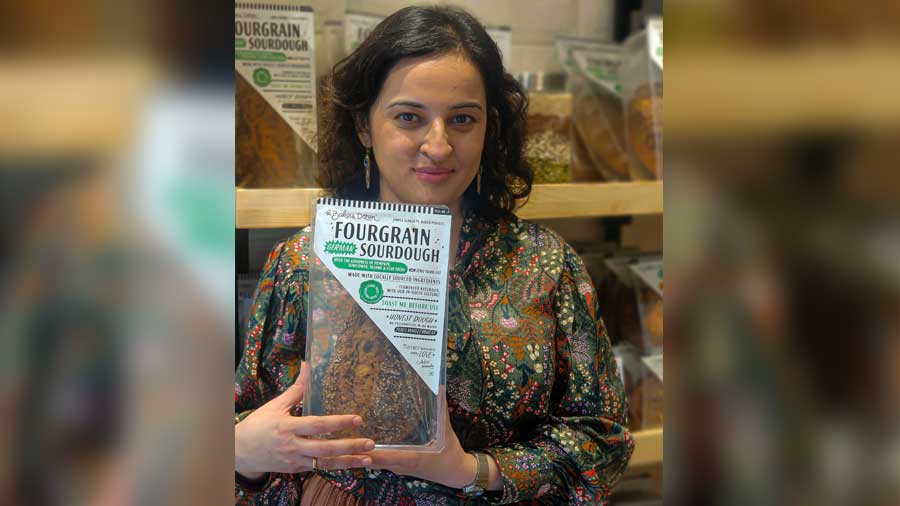Indian baker Aditi Handa’s artisanal label The Baker’s Dozen sold a million sourdoughs in 2020. Handa tells us she has a three-point method to determine the worthiness of a sourdough loaf — a dark and crackly texture, a balanced tang, and the webbing or the size of holes. Microbiologist Marco Gobbetti also had a similar point-based principle to identify a high-quality, nutritional sourdough — a rating system that’s still used by experts globally.
But what is a layman to do when they need a sourdough for their breakfast table?
Buying a sourdough off the rack need not be a chore. The pre-packaged sourdoughs from Handa’s label are one of the most readily available options in Kolkata. And the baker refuses to compromise her meticulous approach for convenient production.
“We ensure each bread has its own unique recipe to do justice to the origin of the loaf, which is something most commercial brands do not offer. We only use fresh raw materials sourced from local farms,” Handa shares.
So, is artisanal production key to finding the right sourdough loaf, or is there more to it? And what are the tell-tale signs of a good sourdough?
Let there be lightness
A light and airy loaf is usually the right pick, confirms Priyanjali Ray, who runs the popular Kolkata home label Wild Yeast Stories. “Sourdough is not made with commercial yeast, it’s a yeast culture that we develop. Sometimes this can make the loaf a little dense, so the thing to look out for would be lightness. Like any other bread, its taste is determined largely by its lightness,” Ray points out.
There is, of course, a simple science behind sourdough’s airiness. “Keep an eye out for irregularly patterned holes. The wilder the pattern the better the bread, because these irregular holes are crucial to the long fermentation process. These holes give the loaves an opportunity to inflate, thus rising well,” Handa points out.
A sourdough starter goes through a series of fermentation stages that encourages the natural yeasts to create carbon dioxide. These air pockets are essential for a lighter crumb structure.
Rupa Sinha, who has been baking for almost three decades now and just introduced her home bakery Dough, A Bread, also relies on slightly bigger, uneven holes. “They’re pretty easy to spot and a good indicator of a healthy loaf,” she tells us.
The health quotient
Whole wheat and multigrain sourdoughs are gaining ground over regular ones. If you’re placing an order with an artisanal baker, chances are they’re already thinking about offering the highest nutritional value. Ray’s label Wild Yeast Stories is known for its multi-grain sourdough made with a combination of seven grains, wholewheat and rye. Its long fermentation process breaks down carbohydrates, making them easier to digest.
“A happy, regularly fed starter produces flavourful and healthy bread. This essential fermented culture is used to make naturally leavened sourdough. Each starter has its own unique and distinctive blend of wild yeast and beneficial bacteria,” shares Fravashi Ava, whose label, The Oval Loaf, offers seeded sourdoughs with sesame and pumpkin seeds.
What’s in a crust?
The textural details on the outside of sourdough can be an indicator of its flavour. Handa relies on a blend of crusty, crackly and crumbly texture. “It’s difficult to attain the evenly crusty flavour and the required moistness. A consistent and crusty texture can tell you if the bread lacks taste or flavour. When it comes to sourdough, the crustier the better. If on pressing it the bread can spring back to its normal shape, that is also a good sign of a properly baked sourdough loaf,” Handa tells us.

Aditi Handa’s pre-packaged sourdough is a top-seller in Kolkata
Most mass-produced or store-bought loaves use a small amount of sourdough starter and are made with artificial flavours and commercial yeast that help the bread rise. “Being a consumer-driven label, we cannot compromise on the quality of bread. So, we allow the starter to rise naturally and do not use any artificial preservatives. Moreover, most commercial bakers usually opt for a machine-made approach and they do not have the expertise or the artisanal touch,” Handa adds.
If you’re in a hurry and have to opt for a store-bought, pre-sealed sourdough instead of a made-to-order one, make sure you are aware of the label’s production process. “A good advice for bread lovers is to always pick handcrafted bread that uses natural ingredients and has been made using traditional methods,” Handa confirms.
Tasting triumphs
Opt for long-fermented loaves if you want a tangier sourdough. The longer the raw dough is allowed to proof and ferment, the more lactic and acetic acid it develops, adding to its tartness.
Sinha tells us she needs at least seven to eight days to make sourdough in the current Kolkata climate (the colder the environment, the slower a starter will grow). “You can make sourdough in 6 hours and you can make it in 36 hours. When you’re fermenting it for longer, it involves a cold fermentation. It develops more flavours when you cool it,” Ray points out.
The trendiness quotient goes a long way in boosting sourdough’s popularity, but its health aspects are undeniable. “It is something that’s trending at the moment, but people definitely want a healthier breakfast alternative even if they don’t always understand the science behind it. Most people don’t even want it very sour!” Ray adds.
Sourdough 101: If you haven’t cut into the sourdough loaf, wrap it in a cotton or mulmul shopper bag as Sinha suggests. This prevents the sourdough from drying out too fast and lets it breathe. However, if you have sliced the loaf, store it in an airtight container and stash it in the fridge, as advised by Ray.
